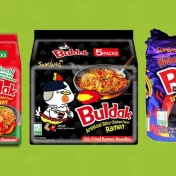For centuries, the debate between dark meat and white meat has echoed across dining tables.
Especially during festive times like Thanksgiving, the choice of meat becomes more than just a culinary preference—it’s almost a tradition.

Whether you’re team turkey breast or drumstick, understanding the science and history behind these meat types can add depth to your next dinner conversation.
Thanksgiving sees a surge in turkey consumption, with millions facing the ‘dark vs. white meat’ choice.
While some people swear by the rich flavor of dark meat, others prefer the lean and light texture of white meat. But have you ever wondered what makes these meats different in the first place?
Is it just the color, or is there a deeper science at play? This guide will unravel these mysteries and more, as we delve into the world of dark vs. white meat.
“Food is symbolic of love when words are inadequate.” – Alan D. Wolfelt
Scientific Explanation of Meat Types
At the heart of the dark vs. white meat debate is biology. To appreciate the difference, we must first understand the types of muscles that constitute these meats and the roles they play in an animal’s body.
Fast-twitch vs. Slow-twitch Muscles
Animals, including humans, possess two main types of muscle fibers:
Fast-twitch muscles (White Meat)
- Characteristics: These muscles are lighter in color and are built for quick, short bursts of energy.
- Usage: Think of a chicken suddenly flapping its wings or a turkey taking a brief flight. These actions require quick energy, and that’s where fast-twitch muscles come into play.
- Location: Typically found in the breasts and wings of birds.
Slow-twitch muscles (Dark Meat)
- Characteristics: Darker in color, these muscles are designed for endurance and can sustain activity over a more extended period.
- Usage: Consider the constant movement of a duck’s legs as it swims. Such prolonged activities rely on slow-twitch muscles.
- Location: Generally located in the legs and thighs of birds.
Muscle Type Comparison
| Muscle Type | Color | Usage | Common Location in Birds |
|---|---|---|---|
| Fast-twitch | White | Short bursts of energy | Breasts and Wings |
| Slow-twitch | Dark | Prolonged activity | Legs and Thighs |
The Role of Myoglobin
Beyond muscle type, another crucial factor in determining meat color is myoglobin, a protein responsible for delivering oxygen to muscles. Think of myoglobin as the muscle’s version of blood’s hemoglobin.
- The more a muscle is used, the more oxygen it requires. This demand translates to a higher myoglobin concentration, making the muscle appear darker.
- Less active muscles, like the breast of a turkey that doesn’t fly often, have a lower myoglobin concentration, leading to whiter meat.
Case Study: Turkeys vs. Ducks
- Turkeys: Despite being birds, turkeys don’t fly much. As a result, their breasts and wings, which are less frequently used, are white. However, since they stand and walk around most of the day, their legs contain dark meat.
- Ducks: Ducks lead a more active lifestyle, both flying and swimming regularly. This constant activity means even their breasts and wings contain darker, slow-twitch muscles.
“Our food should be our medicine and our medicine should be our food.” – Hippocrates
Culinary Differences and Implications
When it comes to the kitchen, the debate over dark vs. white meat is as much about flavor and texture as it is about nutrition. Chefs and home cooks alike have their preferences, often influenced by the dish they’re preparing.
Taste and Texture
White Meat:
- Taste: Milder in flavor, it can be described as slightly sweet with a subtle savory undertone.
- Texture: Leaner and more tender, it has a finer grain. This makes it more susceptible to drying out if overcooked.
- Best For: Dishes that require quick cooking or where the meat’s flavor shouldn’t overpower other ingredients, such as salads or light stir-fries.
Dark Meat:
- Taste: Richer and more robust, dark meat has a more pronounced poultry flavor.
- Texture: It is denser and contains more fat, making it juicier and more forgiving during cooking.
- Best For: Slow-cooked dishes like stews or roasts, where the meat’s flavor can shine and its texture remains succulent.
Cooking Tips
- Avoiding Dry White Meat: Since white meat is leaner, it can quickly become dry when overcooked. Brining or marinating can help retain moisture. When roasting, it’s often recommended to cook the bird breast-side down for part of the time to let the juices flow towards the breast.
- Maximizing Dark Meat Flavor: To bring out the rich flavor of dark meat, consider searing or browning it first. This caramelizes the surface, enhancing its natural taste.
Nutritional Considerations
While both white and dark meat are excellent protein sources, they differ slightly in their nutritional profiles:
| Nutrient | White Meat (per 100g) | Dark Meat (per 100g) |
|---|---|---|
| Calories | Lower | Higher |
| Fat | Less | More (especially saturated fats) |
| Protein | Slightly Higher | Slightly Lower |
| Vitamins & Minerals | Generally Lower | Higher in certain nutrients like zinc and iron |
Note: Exact nutritional values can vary based on the bird, its diet, and how the meat is prepared.
Cultural and Historical Preferences
The choice between dark and white meat is not just a matter of taste or nutrition. Over the centuries, cultural, historical, and even economic factors have shaped our preferences and attitudes towards these meats.
Historical Evolution
- Ancient Civilizations: In ancient times, the whole bird was considered a delicacy, regardless of meat type. Poultry was often reserved for special occasions and religious ceremonies.
- Medieval Europe: Dark meat was sometimes seen as more robust and nourishing, suitable for laborers and warriors. In contrast, white meat, with its delicate texture, was often associated with the upper class.
- Modern Times: With the rise of commercial poultry farming in the 20th century, there was a shift in preference in some Western countries towards white meat. This was influenced by marketing campaigns promoting it as a healthier option.
Cultural Variations
- Asian Cuisines: In many Asian countries, dark meat is often preferred for its juiciness and rich flavor. It’s commonly used in stews, braises, and stir-fries.
- Western Cuisines: While white meat has been popular in dishes like sandwiches and salads, there’s a resurgence in the appreciation of dark meat, especially in gourmet cooking.
- Festive Choices: In many cultures, specific dishes are associated with celebrations. For instance, during Thanksgiving in the US, the choice between dark and white turkey meat becomes a centerpiece of the meal.
Economic Implications
- Pricing: In some markets, white meat, especially chicken breast, is priced higher due to its perceived health benefits and demand. In contrast, in other regions, dark meat fetches a higher price because of its flavor and culinary versatility.
- Supply & Demand: The popularity of certain dishes or cuisines can influence meat demand. For example, the rise of grilled chicken sandwiches in fast-food chains boosted white meat demand.
You May Also Enjoy Reading:
Ethical and Environmental Considerations
The debate over dark vs. white meat extends beyond taste and culture. In our modern world, where sustainability and ethics are at the forefront of many consumers’ minds, it’s essential to consider the broader implications of our poultry choices.
Ethical Implications
- Factory Farming: Many concerns arise from the industrial-scale farming of poultry. Birds are often raised in cramped conditions, with little room to move or exhibit natural behaviors. This has led to growing demand for free-range and organic options.
- Slaughter Practices: The methods used to slaughter poultry can vary widely. Ethical considerations revolve around ensuring the birds are treated humanely, with minimal stress or pain.
- Waste and Efficiency: Interestingly, the preference for white meat in some regions and dark meat in others has led to cross-border trade of these parts. This can be seen as both an efficient use of resources and a reflection of globalized tastes.
Environmental Impacts
- Water Usage: Poultry farming, like all animal farming, requires significant amounts of water, both for the birds and for growing their feed.
- Carbon Footprint: While poultry has a lower carbon footprint than red meat, it still contributes to greenhouse gas emissions, especially in large-scale operations.
- Land Use: Expansive areas are cleared for poultry farms, impacting natural habitats and biodiversity.
- Feed Production: The majority of poultry feed comes from crops like soy and corn. The cultivation of these crops can lead to deforestation, especially in sensitive areas like the Amazon.
Making Ethical Choices
For those concerned about the ethics and environmental impacts of their food choices:
- Buy Local: Reduces the carbon footprint associated with transporting food.
- Choose Free-Range or Organic: While they might be pricier, they often have better animal welfare standards.
- Educate Yourself: Understand where your food comes from, and the practices of the brands you support.
- Consider Alternatives: With the rise of plant-based diets, there are now numerous alternatives to poultry that are both tasty and sustainable.
Reader’s Opinion: Personal Preferences and Traditions
At the end of the day, the choice between dark and white meat is deeply personal. It’s influenced by myriad factors, from childhood memories to health considerations.
Let’s delve into some of these factors and see how they mold our poultry preferences.
Family Traditions
For many, the choice is rooted in family traditions. Perhaps Sunday dinners always featured a roasted chicken with crisp, white breast meat, or festive occasions called for slow-cooked dark meat in a rich gravy. These memories can shape our preferences for a lifetime.
Health and Nutrition
As we’ve touched upon earlier, white meat is often perceived as the healthier option due to its lower fat content.
However, dark meat offers its own set of nutritional benefits, including higher levels of certain vitamins and minerals.
For those watching their calorie or fat intake, white meat might be the go-to choice. Meanwhile, those looking for richer flavors and a juicier texture might gravitate towards dark meat.
Culinary Adventures
Food enthusiasts often love experimenting. Trying different cuisines can lead one to develop a taste for specific meat types.
For instance, many Asian dishes leverage the rich flavor of dark meat, while Mediterranean recipes might highlight the delicate taste of white meat.
Your Take
- What’s Your Choice? Do you have a steadfast preference, or do you enjoy both equally?
- Festive Favorites: Thanksgiving, Christmas, or any other festivity – what’s your go-to meat?
- Cooking Chronicles: Any memorable cooking experiences or disasters related to dark or white meat? Share your stories!
Nutritional Comparison – White vs. Dark Meat 100 g serving
| Nutrients | Chicken Thighs (Skinless) | Chicken Legs (Skinless) | Chicken Breast (Skinless) |
| Calories | 175 kcal | 155 kcal | 146 kcal |
| Fat | 8.43 g | 6.59 g | 1.73 g |
| Saturated fat | 2.60 g | 1.90 g | 0.59 |
| Protein | 25.95 g | 23.84 g | 32.58 g |
| B1 | 0.14 mg | 0.13 mg | 0.09 mg |
| B2 | 0.25 mg | 0.30 mg | 0.11 mg |
| B3 | 8.2 mg | 6.3 mg | 17.1 mg |
| B12 | 0.84 mcg | 1.20 mcg | 0.27 mcg |
| Iron | 0.95 mg | 0.93 mg | 0.48 mg |
| Zinc | 2.23 mg | 2.28 mg | 0.97 mg |
| Phosphorus | 207 mg | 202 mg | 269 mg |
| Potassium | 307 mg | 323 mg | 430 mg |
Conclusion
The debate between dark vs. white meat is a rich tapestry of science, culture, history, and personal preference.
Whether you’re a die-hard dark meat enthusiast or a white meat aficionado, understanding the nuances behind your choice adds depth to every bite.
So the next time you’re faced with the poultry predicament, remember the journey of knowledge you’ve embarked upon and savor the experience.



